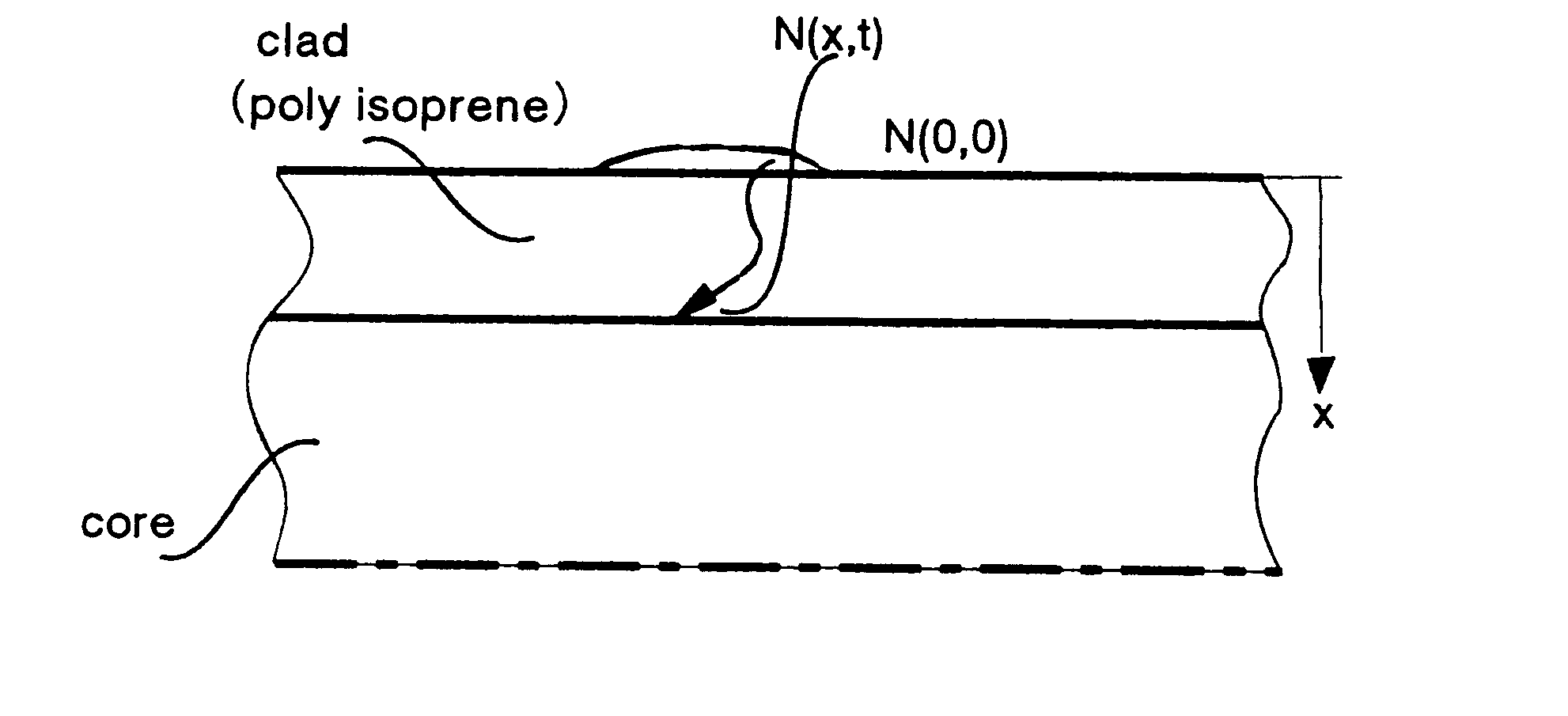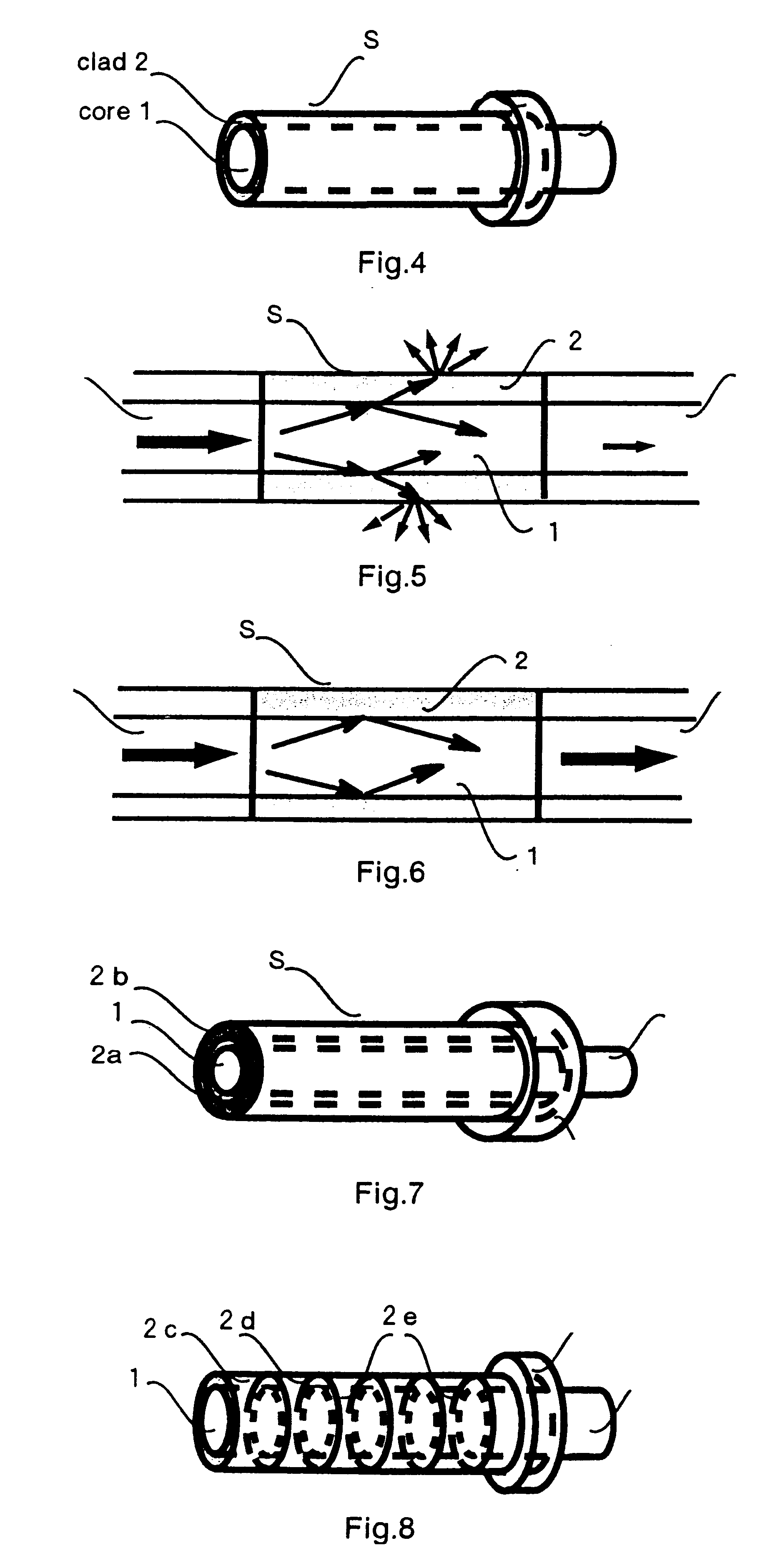Optical sensor and sensing method
a technology of optical sensors and sensing devices, applied in the direction of photometry using electric radiation detectors, optical radiation measurement, instruments, etc., can solve the problem of large change in optical outpu
- Summary
- Abstract
- Description
- Claims
- Application Information
AI Technical Summary
Benefits of technology
Problems solved by technology
Method used
Image
Examples
example 1
Method to Measure Hexane
Plastic fiber core made of Atone (made by Fujitsukasei) with an index of refraction of 1.51 was used as the core material. Polyisoprene with molecular weight of 410,000 and index of refraction of 1.52 was used as the clad material.
A film of thicknesses of 4 .mu.m, 6 .mu.m and 8 .mu.m was spin coated from the isoprene solution. These films were attached to the Atone core with diameter of 1 mm and length of 20 mm. FIG. 4 shows the core 1 and clad 2 and the resulting sensor S.
The sensor S was made into sensor device shown in FIG. 9. Hexane was measured using this system, and the result is shown in FIGS. 16 to 18.
When the sensor S is exposed to hexane, the index of refraction of clad 2 will begin to decrease. The index of refraction changes of n.sub.co.ltoreq.n.sub.cl to n.sub.co <n.sub.cl occurs. The sensor changes from the light leakage mode to the wave guide mode. The light output intensity will increase considerably as measured by light detector such as a pho...
example 2
Method to Measure H.sub.2 O
A solution of 10% polyvinyl alcohol (PVA) in water is coated on the surface of the plastic fiber core Atone (made by Fujitsukasei). Atone with an index of refraction of 1.51 is used as the corel material. After the water evaporates, PVA is cross linked by immersing the coated core into a solution of 1 M hydrochloric acid with 5% aqueous glutaraldehyde for 10 min. at 30.degree. C. The coated PVA is 5 km, and becomes clad 2. The sensor S like one shown in FIG. 4 is formed. The sensor is used to form a sensor device as shown in FIG. 9. The result of using this system to measure H.sub.2 O is shown in FIG. 19.
When the sensor is placed in the H.sub.2 O environment, then the index of refraction of clad 2 decreases, and changes from n.sub.co.ltoreq.n.sub.cl to n.sub.co >n.sub.cl. The sensor changes from light leakage mode to wave guide mode, and consequently, the light output intensity of light emitter like photodetector (6) increases making the detection of H.sub...
example 3
Method to Measure Diethylether
Novolak resin, the clad material, was fabricated as follows: 50 g of purified phenol, 37 ml of 37% formaldehyde aqueous solution, and 0.03 ml of aqueous solution of HCI (35%) for catalyst was added to a 500 ml four-necked flask. The flask is heated in an oil bath while the mixture is stirred. The mixture is refluxed for an additional 2 hours at 90.degree. C. The reacted material is then transferred to an evaporation dish and precipitated in ice water.
This novolak polymer is coated around the corel material made from Atone to form a 5 .mu.m clad 2 material. A sensor similar to that shown in FIG. 4 is formed. The sensor S was made into sensor device shown in FIG. 9. Diethylether was measured using this system, and the result is shown in FIG. 20.
When the sensor is placed in the diethylether environment, then the index of refraction of clad 2 decreases, and changes from n.sub.co.ltoreq.n.sub.cl to n.sub.co
PUM
 Login to View More
Login to View More Abstract
Description
Claims
Application Information
 Login to View More
Login to View More - R&D
- Intellectual Property
- Life Sciences
- Materials
- Tech Scout
- Unparalleled Data Quality
- Higher Quality Content
- 60% Fewer Hallucinations
Browse by: Latest US Patents, China's latest patents, Technical Efficacy Thesaurus, Application Domain, Technology Topic, Popular Technical Reports.
© 2025 PatSnap. All rights reserved.Legal|Privacy policy|Modern Slavery Act Transparency Statement|Sitemap|About US| Contact US: help@patsnap.com



